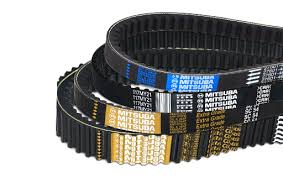Automotive Belts are power transmission belts that provide a connective link between two parallel rotating shafts, these shafts are fixed with pulleys upon which the belt is looped. Hence, power transmission occurs by friction from the driving shaft to the driven shaft smoothly through these belts. Automotive belts are also utilized as timing belts to synchronize the functions of engine valves via a camshaft. Automotive belts used in vehicles are designed as endless belts and are commonly manufactured from materials such as neoprene, chloroprene, and ethylene propylene diene monomer rubber (EPDM rubber). The inner surface and the cross sectional area of the automotive belt differs according to the function the belt needs to perform. Automotive functions such as air-conditioning, power steering function, water pump function and drive alternator are performed by the V-belt while valve timings through the camshaft is usually performed by the toothed belt. Serpentine belts are newer form of automotive belts where all the automotive functions, collectively known as engine accessories, are performed by the connections through a shaft and pulley system is done by a long single endless belt. This form of belt negates the usage of multiple V-belts in an automotive engine.
Automotive Belts Market Dynamics
The Production numbers of automobile worldwide is on a constant increase on a yearly basis as per the demands witnessed in many developing countries. This factor is the prime reason for fueling the growth of the automotive belts market. Automotive belts primarily function through friction between the pulley and the belt which is susceptible to wear and tear due to continuous usage leading to decreased performance, engine efficiency and slippage. This problem is usually rectified by the replacement of the belt prompting the growth of the automotive belt market in the aftermarket segment as well. The influence of the Environmental Protection Agency to reduce greenhouse gases emission and control of pollution has pushed the automotive vehicles manufacturers to produce highly efficient and less polluting engines that require very precise and long lasting automotive belt. This factor has also fueled the growth of automotive belts market as more and more vehicle manufacturers opt for belts that are efficient and environmental friendly.
Request For Report Sample @ https://www.futuremarketinsights.com/reports/sample/rep-gb-1785
Automotive Belts Market: Segmentation
Automotive Belts Market can be segmented by vehicle type, sales channel and type.
By vehicle type, automotive belts can be segmented as:
Passenger vehicles
Light Commercial vehicles
Heavy Commercial vehicles
By sales channel, it can be segmented as:
Original Equipment Manufacturer
Aftermarket
By type, it can be segmented as:
Timing Belts
Drive Belts
Single V-Belt
Multi-function V-Belt/Serpentine Belt
Automotive Belts Market: Regional Outlook
The Global Automotive Belts market can be segmented into seven distinct geographical divisions such as North America, Latin America, Western and Eastern Europe, Asia-Pacific Excl. Japan (APEJ), Japan, Middle East and Africa. Developing countries in Latin America and the Asia Pacific region such as Mexico, China and India witnessed the fastest growth of automobile production and sales which can further fuel the improvement of automotive belts market. In APEJ region China, South Korea, and India are the top automobile producing countries making them prominent market for automotive belts. In the North American region U.S. is anticipated to show high growth of automotive belts market owing to improved production of automobiles. Western Europe is exhibited to show a prominent growth of automotive production especially in countries such as Germany, Spain, France, U.K., and Italy hence enhancing the market for automotive belts in Western Europe. The increasing trend of reselling automobiles in the Middle East and Africa region has prompted an improvement in the demand for automotive belts, thereby improving the market in the aftermarket segment.
Request For Report Table of Content (TOC):https://www.futuremarketinsights.com/toc/rep-gb-1785
Automotive Belts Market: Key Players
Some of the major players identified in the Global Automotive Belts Market are Gates Corporation, Midas International Corporation, Mitsuboshi Belting Ltd. Group, Helicord , ransmissions Pvt. Ltd., B&B Manufacturing, The Carlstar Group LLC, Continental AG, Bearings and Power Transmission Solutions.



